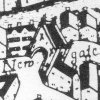The Abbey Gatehouse
The gatehouse on College Green was once the entrance to the Abbey of St Augustine, but there's a puzzle wrapped up in that.

The Abbey Gatehouse on College Green. The large archway was for wheeled traffic and the small one for pedestrians. There were once a pair of heavy doors on the main gate. You can still see the hinges for them. The smaller gate also had a door. Beside it was the porter's lodge.
The magnificent gatehouse beside Bristol Central Library is a familiar sight to Bristolians. Recently cleaned, its stonework glows in the Spring sunshine. It was once part of the great abbey dedicated to St Augustine, later converted into a cathedral. But what exactly was it for?
A monastery is a place of seclusion. One feature you can count on is a stout wall around the whole site. Within its shelter men could concentrate their minds heavenwards. Or that was the theory. The monastic gate shut out the sinful world. So we might imagine that this fine gate at Bristol was set in the outer wall of the abbey precinct. But we would be wrong. The whole of College Green lay within the abbey precinct originally. What is now a swathe of grass, rimmed with walks and flowerbeds, was once the abbey cemetery.
So where did our gatehouse fit in? The grandest abbeys could have an outer gate and an inner one. Picture yourself as a weary traveller arriving at a great monastery. You knock on the outer gate. The porter pops out to hear your plea for bed and board. Since monasteries were bound to provide hospitality, you are admitted into the outer court. Your horse is led off to the stables, while you are shown to the guesthouse. On the way you might pass workshops, barns and even animal pens and meadows in rural monasteries.
But let's suppose that you are a nobleman. Then you would be ushered through a second gatehouse into an inner court. Here could be storehouses, brewhouse, bakehouse and accommodation for important visitors, perhaps in the abbot's own quarters. So your blue blood got you one step closer to the heart of the monastery. The inner sanctum was the cloister. No-one should penetrate that but monks and priests.
So it was at St Augustine's in Bristol. This inner gatehouse led into a courtyard lined with lodgings, granary, bakehouse, brewhouse and stables for the gentry. At the far end of the courtyard yet another gateway (which also survives) led into the abbot's quarters. So what happened to the outer gate? That is intriguing. We need to delve into the history of the monastery to work it out.
St Augustine's was founded by Robert Fitzharding, a rich citizen of Bristol, in 1140. Within a few years he had built a church and monastic buildings solid enough for a group of canons to move into. Canons were monk-priests. It is from them that we get the name Canon's Marsh. Over the next decades building work went on. Probably Fitzharding had thrown up timber buildings to start with, and these were gradually replaced in stone. What survives of the Norman work shows how splendid a monastery it was. The Norman chapter house is one of the finest Romanesque buildings in the country. Our gatehouse is another remarkable survival. Or at least the lower part of it is Norman, with the characteristic round arches and zig-zag decoration.

A Tudor rose slotted into the masonry above the Norman archway.

Abbot Newland's badge: a heart pierced by three nails and shedding blood. From this came his nickname Nailheart.
The upper part of the gateway is Tudor. It is the work of Abbot Newland, who was an enthusiastic builder. He rebuilt a staggering amount of the monastery, marking his works with his badge. His lovely Tudor oriel windows were replaced in the 18th century by Georgian sash windows. Fortunately a drawing was made of the gatehouse before this, so it could be restored to its former glory in Victorian times.
The first description of the precinct comes in 1480 from William Worcester. Curiously he talks of an entrance to it, rather than a gate, at the east end of what is now College Green. On the west side he describes two gates onto Frog Lane. Worcester clearly had free access to wander around the green and take measurements. It all suggests that the canons had abandoned the outer gates and were only manning the inner one by this time. A few years before the abbey was dissolved, the abbot described the green as adjacent to the precinct, not within it.
What would cause such a shift? St Augustine's had endless battles over the green with Gaunt's Hospital, which also faced onto it. Then there was the parish church of St Augustine the Less, built within the original precinct by the abbey. Parishioners would need access to that. With all these comings and goings, monastic retreat into the inner enclosure might make sense. Whatever the truth of the matter, the gatehouse gives a fascinating glimpse into a life long gone.

























